Ramon Cedeño
Professor – Group A
Bioregional Education Program
Planet Drum Foundation
Midterm Report – English
(Click here for Spanish/Español)
July 6th, 2010
We have now begun the classes with new teachers and class assistants. It’s normal for everyone to see the many happy faces of young students, who are part of the change that we want. It’s beautiful to see so many boys and girls. This year has exceeded our expectations, since all of the classes are overbooked.
During our first class we introduced ourselves and presented our principle objective which is to recognize and understand each of the characteristics of our bioregion, the different types of ecosystems that exist in the dry tropical forest through class materials, games and field trips.
Raisa is my class assistant and on the first day our group decided to name themselves Los Exploradores (The Explorers). Our class is full of all kinds of kids. There are hyper-active kids who want to be involved in everything all at once. And there are students that everyday are asking questions about the new information they are learning.
During the first field trip, one of the students, Arroba, shouted: give me a B, I, O, R, E, G, I, O, N; and the Exploradores all shouted BIOREGION. While on this trip to the big cross which overlooks Bahia, I showed the students some of the trees that Planet Drum has planted: Guachepeli, Pechiche, and many more. The students admired how big the trees are. From the hilltop, I showed them the characteristics of the bioregion: the watershed of the Río Chone, the mountains and landscapes where the flora and fauna is and the different species of trees, the type of soil that characterizes our bioregion.
The Exploradores are a group with a lot of energy on all of the field trips. Luis Cuellar is a bright, young student who is very enthusiastic and is always asking about the names of trees and animals (squirrels, anteaters, deer, and ocelot, for example) that live in the forest.
On our hike to the Bellaca Point beach, the students were very interested in the nests of Lincheros (Yellow-tailed Oriole, which makes a hanging nest). I explained that it is a bird that migrates to Ecuador during the winter months. While here, they find mates and reproduce. Once we arrived at the beach, the kids enjoyed a nice dip in the ocean.
During another field trip, to the Bellavista neighborhood, I told them about how the neighborhood is well-integrated and good at organizing itself around causes. The students noticed how clean the neighborhood was. I said that it is like an ecological neighborhood or green community within Bahía, and it is through the classes and their work that they will achieve their goals.
Once we had climbed to the lookout atop one of the hills, I explained again the layout of the surrounding watersheds. We could see the great Ceibo trees and other species, such as Laurel which were flowering. I also explained about the cold ocean current, the Humbolt, which flows north past Bahia to Cape Pasado and then turns out to the Galapagos Islands.
On the way home, the kids all stopped at a small, local store to buy some snacks. It occurred to me that we were helping the neighborhood shops and community members by supporting their small businesses.
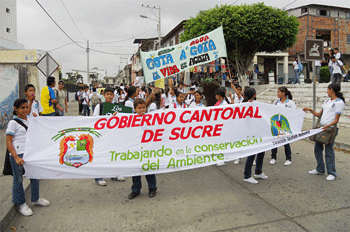
On June 5th, all of the Bioregionalism students participated in a parade that was part of celebrations for the week of the environment. I noticed that the kids put their trash in their pockets and backpacks instead of throwing it on the street. This gave me pride and showed me that they have had a change in mentality.
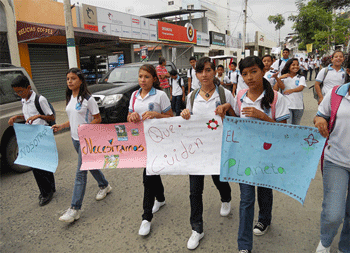
For the week with the ‘Land Ecosystems’ theme, we visited the Cerro Seco nature reserve.
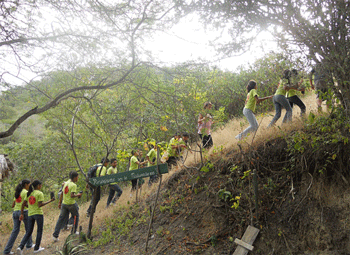
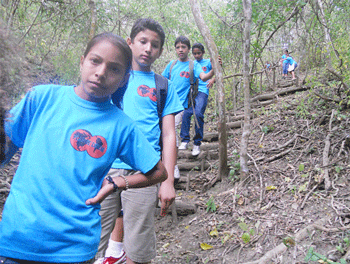
I had to help with one of the other classes so my assistant Raisa guided our class on the hike. She observed that the kids were very well-behaved and explained how she organized the class with the help of Lissette, a former Bioregionalismo class assistant. Raisa reported that the class went very well.
One surprise for me was during the ‘Soil’ themed week, when most of the children could not differentiate between organic and inorganic wastes, so I had to explain this to them.
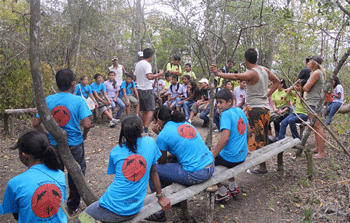
That Friday we took a field trip to the greenhouse and the students got to see first hand how organic waste decomposed in the compost pile. While there, Orlando Arias, Planet Drum’s Field Projects Foreman explained this process and how soil is mixed for growing trees. Orlando told the students about the different kinds of trees and how some produce fruit, such as Tamarind and Chirimoya. He showed them the seed beds and how trees germinate from seeds, then are transplanted and organized into groups of 100. Then he asked if they could identify the species of one of the trees that is growing in the greenhouse. Luis said he could, but that he had forgotten the name. He asked me to tell him what the species name started with, and I told him “Bo…” He quickly responded: “Bototillo!” All of the other students laughed and then when I said that he was right, they clapped and congratulated him.
Then Elodie, a Planet Drum volunteer, spoke about the work that the volunteers do at the greenhouse. She explained how they clear weeds, transplant trees and collect plastic bottles to recycle them as containers for the trees. Then we split into two work groups, one for each pile of soil that had been prepared in advance. Following Elodie’s instructions, the children began filling bottles with the soil. The two groups got into a race to see which could fill up their bottles the fastest. Once the bottles had been filled up, Orlando chose some of the children to go into the greenhouse to get Guachepeli tree seedlings from the seedbed in order to transplant them. The students then planted the seedlings into the bottles that they had filled. Once the work was done, I said that we deserved a round of applause and everyone started clapping. On the bus ride home the children were singing songs until one by one they got off to go to their homes. It was a really great day. And the next week Orlando told me that the kids must have green thumbs because all the trees they had transplanted were doing beautifully.
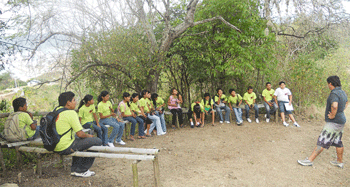
Translated by Clay Plager-Unger
Ramon Cedeño
Profesor – Grupo A
Programa Educativa de Bioregionalismo
Fundación Planet Drum
Informe de progreso – Spanish/Español
6 de Julio, 2010
Hemos empezado las clases con nuevos profesores y asistentes. Es normal para todos ver muchos rostros felices de los jóvenes voluntarios, que son parte del cambio que queremos. Que hermoso es ver la gran cantidad de chicos y chicas, este año ha superados nuestras expectativas.
Nuestra primera clase nos presentamos uno a uno y planteando nuestro objetivo principal que es reconocer y identificar cada una de las características de nuestra bioregión, los diferentes tipos de ecosistemas que hay en el bosque seco tropical con juegos, y en armonía con nosotros mismos por que estamos luchando por un planeta mas sano con las clases que impartimos semana a semana, durante esta semanas.
Raisa es la asistente del grupo LOS EXPLORADORES, nombre que se dieron ellos mismos el primer día de clases. Hay estudiantes hiperactivos que siempre están participando en toda la clases, estudiantes que día a día están preguntando muchas cosas que desconocían por la poca información que tenían.
En nuestro primer recorrido de los exploradores, el voluntario Arroba gritó déme una B, déme una I, déme una O, déme una R, denme una E, denme una G, denme una I, denme una O, denme una N, y todo el grupo de exploradores gritó ¡BIOREGION!
En el recorrido les demostré muchos árboles que han sembrado la Fundación, entre ellos guachapelí, pechiche y muchos más. Se admiraron por el gran tamaño que estos tienen ahora. Desde el punto más alto les enseñe las características de la bioregión, cuenca del Río Chone, las montañas y paisajes donde está la flora y fauna y las diferentes especies de árboles, el tipo de suelo característico de nuestra bioregión que hay en el bosque seco.
Los exploradores son un grupo con mucha energía en los diferentes recorridos. Luis Cuellar, es un joven muy entusiasta que siempre le gusta estar preguntando las clases de árboles que hay aquí y animales entre los que les he nombrado, ardillas, osos hormigueros, venados, tigrillos y muchos más. Cuando hicimos la caminata a Playa Bellaca se interesaron mucho en los nidos de los lincheros. Yo les comenté que son pájaros que migran en el invierno hacia aquí ya que vienen a aparearse, además de muchas otras especies. Después de esto los chicos llegaron a la playa y disfrutaron de un lindo baño.
Cuando estuvimos en el barrio Bellavista, les hable sobre esta comunidad, que es muy organizada. Los chicos en el recorrido me decían está muy limpio este lugar y les dije que ellos ahora están participando como un barrio ecológico o una comunidad verde en Bahía y que por su trabajo y organización están cumpliendo con su objetivo. Cuando llegamos al mirador de este lugar les enseñe otra vez como se forman las cuencas. También podíamos ver los grandes Ceibos y los árboles de Laurel florecidos. Además les hablé sobre la corriente fría del Humboldt que llega hasta el Cabo Pasado y de allí se desvía hacia las islas galápagos. Cuando regresamos, ellos ingresaron a una pequeña tienda donde compraron diferentes cosas. Allí me di cuenta de cómo nosotros reactivamos la economía ya que generamos un poco de ingreso a los habitantes de esta comunidad.
El día 5 de junio todos los Bioregionalistas participamos en el pregón de la semana del ambiente en la ciudad. Veo que los chicos ahora guardan su basura en sus bolsillos o mochilas y veo como ellos tienen un cambio de mentalidad. Esto me llena de orgullo y demuestra que estos chicos quieren ser parte de una nueva generación de jóvenes que se encuentran ya unidos con nuestra lucha de conservación.
En uno de nuestros recorridos, al Bosque en Medio de las Ruinas, Ingrid Melo se asustó al ver muchos gusanos, y los chicos decían que no eran peligrosos. Vi la felicidad de estos chicos en como corren en los senderos. Observaban a los Culebreros y escuché a ellos decir que lindo que es ese pájaro y que hermosos colores tiene.
La cuarta semana evaluamos a los chicos. Una gran cantidad de chicos ya sabían que especies de flora y fauna hay en la bioregión. Unos dejaron mensajes como los de Noemí, diciendo protejamos la naturaleza. Ingrid Melo nos decía como su casa puede ser más ecológica: separando la basura y reutilizando el agua para regar plantas. Luis Cuellar que nos manifiesta que debemos utilizar focos ahorradores para ahorrar energía.
En el recorrido a La Reserva Cerro Seco ellos realizaron el recorrido con nuestra asistente Raisa ya que ella esta semana dio las clases a nuestro grupo con el tema ecosistema terrestre. En su reporte me dice que bien se portaron los chicos y como los organizo en su recorrido que con la ayuda de Lissette llevaron muy bien la clase. Esta clase trabajé con el grupo C los dos días.
Fui muy sorprendido en ver que cuando realizamos el tema ‘el suelo’ los chicos no podían diferenciar lo que eran los residuos orgánicos e inorgánicos. Ese viernes, cuando nos dirigimos a la casa verde de Planet Drum, un grupo nos encontramos aquí en la ciudad y otro grupo ya estaba en la universidad esperándonos. También nos estaba esperando Orlando representante de la Fundación.
Yo invité a los chicos a pasar al vivero y les empecé a hablar sobre como obteníamos el humus, que observáramos como la materia orgánica se estaba descomponiendo. Y después de un proceso donde se encontraban las bacterias descomponedoras que se transformaría eso en suelo. Con ese suelo mismo trabajaríamos. De allí, Orlando les explicó sobre los diferentes tipos de árboles, por ejemplo los frutales como Tamarindo y Chirimoya. Les mostró las camas donde germinan los árboles, y explicó cual es el proceso de esto, también de la organización y ubicación de los árboles que están en grupos de 100. De allí preguntó si alguien conocía un árbol que está dentro del vivero, y Luis Cuellar decía que si pero que no se acordaba del nombre. Me dijo profesor: “dígame con que comienza el nombre.” Le dije: “con BO…” Y muy rápido respondió: “¡Bototillo!” Todos los chicos se rieron. Y yo les dije que era la respuesta correcta. Aplaudieron y lo felicitaron.
Después les presenté a Elodie, una voluntaria para la Fundación Planet Drum, que nos acompañó esa tarde. Le dije que les hablara del trabajo que realizan ellos aquí y ella les empezó a decir que ellos limpian las malezas del vivero, trasplantan los diferentes árboles que hay allí, que recogen botellas para reciclarlas, ya que estas las cortan y ubican una planta en cada una de ellas.
Después de esto hicimos dos grupos de trabajo, ya que había dos montículos de compost, Raisa y Lissette con un grupo y yo con otro grupo. Les dije que ese es el suelo que se obtuvo después de la descomposición de la materia orgánica y les indiqué que realizaríamos el trabajo que nos había dicho Elodie. Es así que los chicos empezaron a llenar las botellas con suelo. Un grupo decía que ganaría, así que les dije que era una competencia y que el grupo que ganaría se llevaría un premio. Después de que estaban llenas las botellas de suelo, Orlando les dijo a unos chicos que ingresaran a ver arbolitos de Guachapelí para trasplantarlos. Una vez terminado el trabajo, los reuní para decirles que merecemos un aplauso y todos empezaron a aplaudir. Después de esto tomamos el bus y los chicos venían cantando hasta que poco a poco se fueron quedando. Fue un día muy bueno, y la semana siguiente Orlando me dijo: “Tus chicos tienen buena mano, todos los árboles están lindísimos.”

Thanks for sharing. I read many of your blog posts, cool, your blog is very good.
Can you be more specific about the content of your article? After reading it, I still have some doubts. Hope you can help me.
Thanks for sharing. I read many of your blog posts, cool, your blog is very good.
I don’t think the title of your article matches the content lol. Just kidding, mainly because I had some doubts after reading the article.